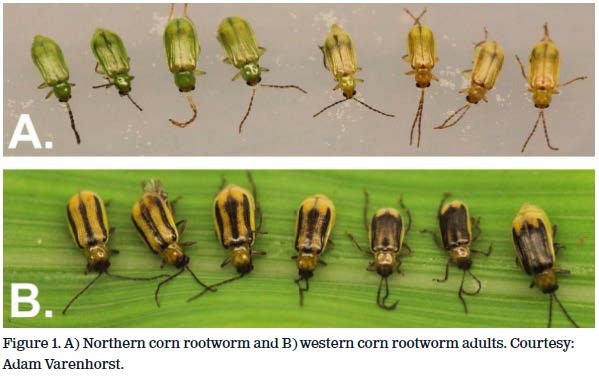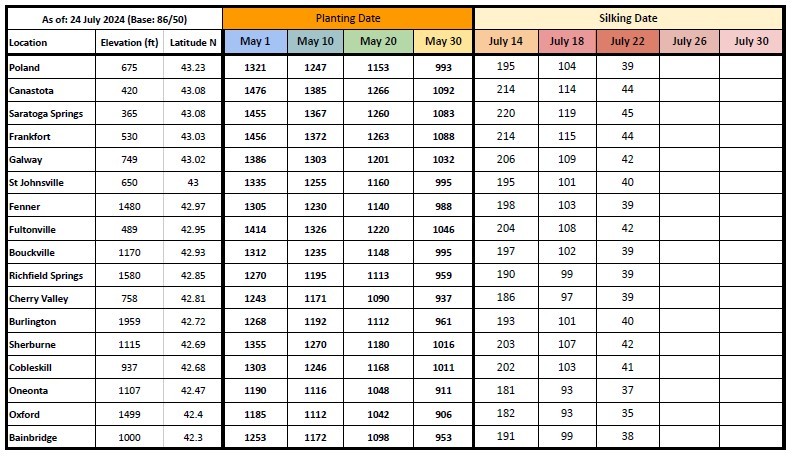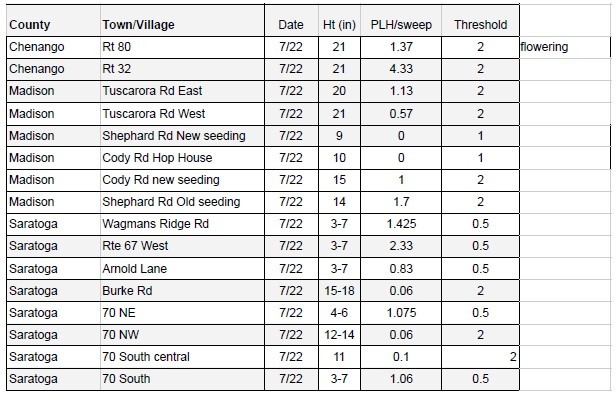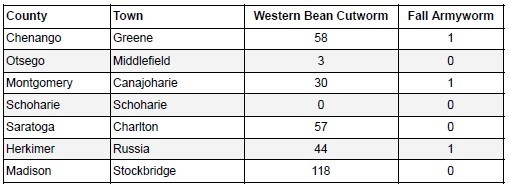Field Crop Update, July 25, 2024
Erik Smith, Area Field Crop Specialist/Team Leader
Central New York Dairy and Field Crops
1. Field Observations and Weather Outlook
More corn tasseling this week, so in addition to checking crops for disease, now is the time to scout for corn rootworm if you're hoping to plant corn into that field again next year. The threshold for Western corn rootworm is roughly 1 per plant, while the threshold for Northern corn rootworm is 2 per plant. See the image below for ID (from South Dakota State Univ. Ext). Here is a video tutorial on corn rootworm scouting from NYSIPM: IPM for Corn Rootworm on Field Corn.
Silage corn needs 750-800 GDD (depending on hybrid maturity) after silking to reach a whole plant DM of 32%. Under typical late season dry down conditions we can expect the crop to reach 35% DM four to seven days later. We can expect to accumulate 20-25 GDD per day, or even up to 30, so peak maturity can creep up on us quickly. But no matter what the numbers say, always check your crop to see how close you may be to harvest. For more details, see this article.
Soybeans are entering R3, so we're nearing the end of the window for protecting crops from white mold risk.
And once again, enjoy this new spell of dry weather while we have it!

2. Growing Degree Days (GDD) (See: Climate Smart Farming Growing Degree Day Calculator)
Growing degree days (GDD) are calculated by taking the average daily temperature and subtracting the base temperature for development of a given organism ((High + Low)/2 - base temp = GDD). For corn silage, we are using base 50/86, as corn development starts at 50 degrees F and ceases above 86. Check your location and planting date:

3. Pest Monitoring
New growth of new seedings of alfalfa tended to be above threshold for potato leafhopper this week (Table 1). Western Bean cutworm and Fall Armyworm are increasing, but I still have yet to see egg masses or larvae in any of these locations (Table 2). I have not seen soybean aphid issues so far - populations are very low.
Table 1. Potato leafhopper scouting:

Table 2. Corn moth trap data

Upcoming Events
2026 Dairy Day
January 13, 2026 : Dairy Day - Hamilton
Hamilton, NY
Lunch included
January 14, 2026 : Dairy Day - Ballston Spa
Ballston Spa, NY
Lunch included
2026 Corn & Soybean Day
January 20, 2026 : Corn & Soybean Day - Hamilton
Hamilton, NY
Lunch included. 2.75 DEC Credits available
January 21, 2026 : Corn & Soybean Day - Ballston Spa
Ballston Spa, NY
Lunch included. 2.75 DEC Credits available
Announcements
Statewide Field Crop Pathology Needs Assessment Survey
Your input is wanted for identifying priorities!Sign Up for Our Weekly E-Newsletter
We send out a bi-weekly e-newsletter that has announcements, upcoming programs, and opportunities for you! Registration is quick, easy, and free. Click here to sign up today!Farmers Can Join MeatSuite For Free!
MeatSuite.com is a free resource provided by Cornell University where NY meat farmers can create a farm profile and list their bulk (wholes, halves, quarters) and bundled (i.e. Grilling Bundle) meat products.Why should farmers join?
1. It's free and easy!
2. Connect with more local customers. In the past year the MeatSuite.com farm directory had 8,300 visits from New York consumers. Farm profiles get as many as 25 views per month from potential local customers. We also spotlight MeatSuite farms on social media and bring attention and purchases to farms through highlights and giveaways.
How do I join?
Farmers can visit https://www.meatsuite.com/farmers/ to create a free farm profile. You must list at least one product for your farm's profile to go live. You'll also have access to Cornell's free Meat Price Calculator, a helpful tool for pricing your meat to make a profit.
While you're on MeatSuite, check out the "Creating Consumer-Friendly Bulk Meats" publication on the log-in page. It has tips on how to create bulk meat products that are easier for first-time buyers to say "yes" to.
If you have any questions as you create your farm profile or products, we're here to help! Please email Matt LeRoux at mnl28@cornell.edu.




